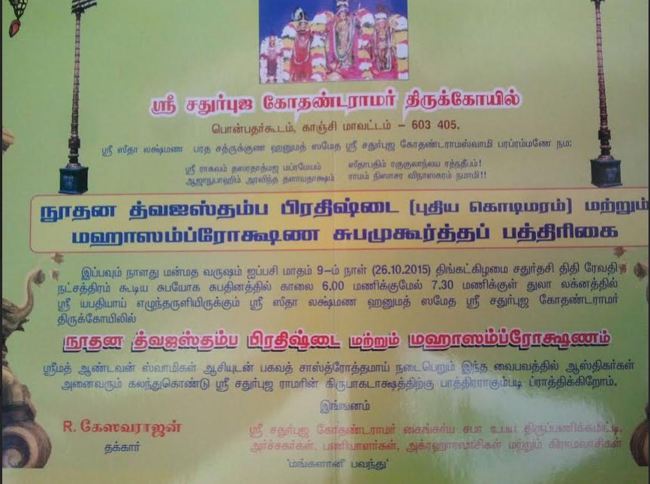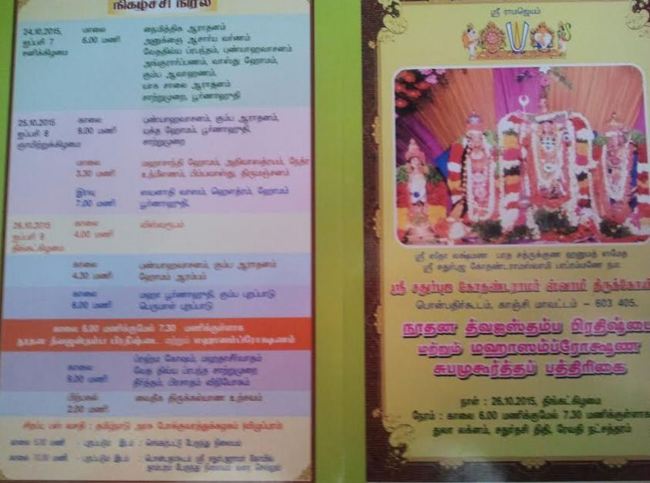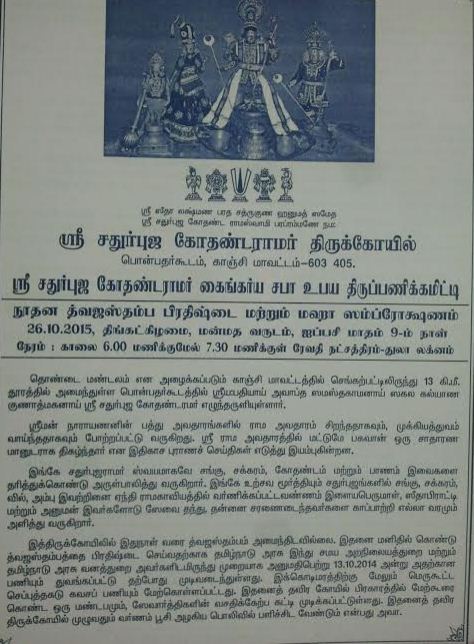
Sri Rama, is the personification of righteousness. ,an exemplar of sixteen most auspicious virtues, and numerous other lovable attributes, truth, manliness ,courage, fortitude, forgiveness , considerateness etc. Sri Sita presents in her immaculate purity, perfect chastity, matchless beauty, steady loyalty, unbounded love and ready forgiveness. Sri Lakshmana an ideal brother, Sri Anjaneya a sincere devoted service oriented guide of all is finding place in all Sri Rama temples. The close affinity that all sections of people feel for this model couple and the reverence in which they hold them are borne out by the fact that even the tiniest village has a temple where they are enshrined and worshipped. Further, the ancient idol of the heroic ages, the embodiment of truth and of morality, the ideal son, brother, king and so on, has been presented before us by great sages in various divyamangala swaroopams. .
One such is Sri Devaraja Maharishi, who had the vision of the appearance of Great Rama Avatara was in the form of Sri Chaturpuja Kothhanda Rama . in Ponpathirkuttam village,Kancheepuram District, Tamilnadu .This temple is located just 13 km from Chengalpattu on Thirukkazhukundram road, near Pon Vilaintha Kalathur. .Nearest Railway station is Otttivakkam, next to Chingleput junction on Villupuram railway track. There, it is splendid darshan of HIM with two arms with Sangam and Chakram and the other two arms with Chin muthras of Abhaya and Varadha. Similarly moolasthanam here is a rare unique, showing Sita and Rama together who constitute supreme phenomenon. They form an inseparable unit. They cohere so close that it is impossible to separate one from the other. The grateful beneficiaries, who notice Sita seated beside Sri Rama on the same pedestal offer worship to both with equal diligence and devotional favor. Sri Chathurbuja Kothandaramar and Sri Sita devi idols with Sri Lakshmana in standing pasture, close to the divine couple and Sri Anjaneya with his mouth closed by his hands in full humbleness before them is the rarest position in any shrine in this country.
Devotees of this temple, which had the previous renovation and Ashta bandana Maha Samprokshanam on 25 th March 2007, felt the absence of Dwajasthambam and so works in this connection was started on 13 10 2014. Necessary permission from the H.R.& C.E. department Government of Tamilnadu was later obtained and the required teak wood is obtained from the Forest department. Installation of Dwajasthambam done initially on 29 6 2015, and subsequently copper plating is done.
Now, ,with the blessings of Srimad Andavan and Srimad Azhagiya singer ,it is proposed to perform the necessary rituals of Kumba yagasalai Aradhanam Homam poornahudhi etc will be from saturday 24 10 2015. Noothana Dwajasthamba Prathishtai and Maha Samprokashanam will be done on Monday 26 10 2015, (9th Aipasi ,Manmatha) from 6 AM to & 30 A.M. Veda Prabhanda Satrumurai will be at 9 A.M. Special Vaaideeha SRI SEETHA RAMA Thirukkalyana uthsavam will be done at 2 pm.
It is our humble request to all devotees to contribute towards this great noble cause and bring the entire kainkaryams successfully. It is estimated that the sum of Rupees Ten lakhs is still needed for conducting this. In continuation of this consecration, Mandalabhishekam for 48 days have to be performed. The contributions exclusively for Vastrams, veda Parayana Goshti sambhavanai, flowers, yagasalai silk above all for Annadhanam is most welcome in this. As the temple is in a village, funds are to be necessarily raised from all affluent bakthas from all over the country, and hence this appeal.
Contributions may be made by draft, cheque or cash in the name of SRI CHATHURBHUJA KOTHANDA RAMAR KAINGARYA SABHA UTC and can be sent to secretary A.J.Sethuraman, A/8 Narangi flats, 51, Thambiah Reddy Street, West Mambalam Chennai 600 033, Tamilnadu, South India (Phone 94445 18810 )
Sarve jana Sukhino bhavanthu
( A short note on Dwajasthambam- In Tamil literatures, we can observe that Dwajathambam, or flag post, is seen in mamy temples in Tamilnadu ,which may be dated Tamil literatures about 2000 years ago. Just like 32 bends in our backbone, Dwajathambams also have 32 bends. Similar to 6 basis and 3 nadis in our backbone, dwajasthambam is also erected in temples. The height of such flag staff is less than the height of Raja gopuram and almost of the same height of shrine vimanam , There is also a specification on its distance from the entrance step. The foundation of flag staff is about one fifth of the height . The basic structure is of square shape just extended a little from the circular post Dwajastambham is a kind of Antenna like structure which receives the cosmic rays and brings it down to the premise of temple.This is placed between the Rajagopuram and the main sanctum. Daily pooja will also be performed for the Dwajasthambam.. Dwajasthambam is referred to as being a medium for the Heavens to be connected to the earth, which would refer to it being a spiritual connector between us earthlings, and the Supreme Being, God.There is a widespread belief that the Dwajasthambam gives an idea to a devotee from a long distance about the idol installed in the temple.
A Dwajasthambam usually represents the prosperity and pride of a temple. But some texts do suggest that the bottom of a flag post symbolizes Shiva, middle portion Brahma and the top portion Vishnu. It can be noticed that the top of the DhwajaStambha is the highest point of the temple, and thus, whenever lightning would strike, the temple would be saved from the devastating damage that could have been caused. Whenever lightning strikes, the metal arrestor placed such that it is the highest point of the region, and induces the charge to conduct through it. The Arrestor then conducts the heavy electrical impulse directly to ground, thus preventing the building from getting damaged. This is what could be meant from the explanation that it connects “Heaven to earth” .Hence it is a kind of Antenna like structure which receives the cosmic rays and brings it down to the premise of temple. The dwajastham is the backbone of the temple. There is a hope that the adjoining buildings should not raise their building above level to the dwajasthambam. )
Pathrigai:
Courtesy:Rangarajan A J











